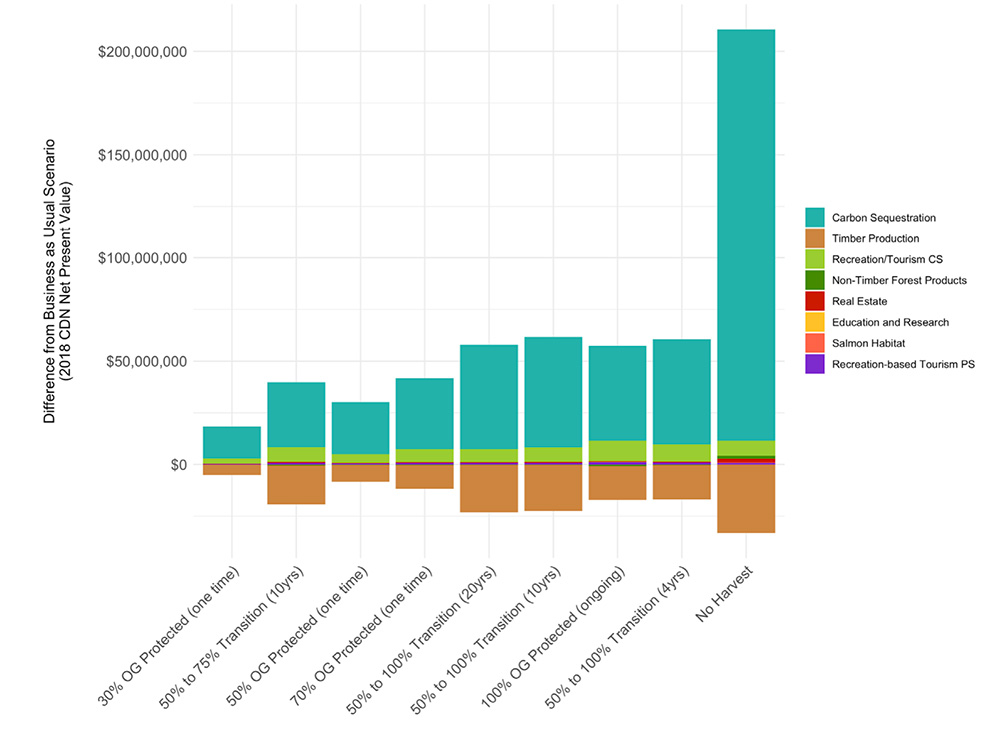Economic Valuation of Old Growth Forests in British Columbia
Photo credit: Eden Grove Old Growth”, by TJ Watt (n.d.), Ancient Forest Alliance
Project Details
Location: |
British Columbia, Canada, 54.82861, -125.18094 | |
Client: |
Ancient Forest Alliance; Metcalf Foundation & Wilburforce Foundation | |
Duration: |
2019 – 2024 | |
Team Member(s): |
Cedar Morton, Alexandra Tekatch, Frank Poulson, Sarah Beukema, Ryan Trenholm | |
Practice Area(s): |
Nature Based Solutions | |
Services Employed: |
Ecological modelling, GIS analysis, Natural asset inventory, Natural asset planning and decision support, Economic assessment, Science communications |
The Problem We Aimed to Solve
Old-growth forests produce coveted timber products, but they also provide many other ecosystem services free-of-charge that would be costly or impossible to replace. When decisions are made to log, these ecosystem services are not considered on equal footing with timber harvest revenues, which risks leaving society worse off. To support decision-makers by making this tradeoff more transparent, the Ancient Forest Alliance wanted to understand how the economic benefits from a range of old growth ecosystem services (including timber production) would change under different harvest practices. We explored these benefits in a pilot study of forests near Port Renfrew, BC, then, with funding support from the Metcalf Foundation and Wilburforce Foundation, scaled up to a provincial level pilot study that evaluated a similar suite of ecosystem services for two Timber Supply Areas (TSAs) in BC: the Prince George TSA and the Okanagan TSA.
How We Helped
ESSA assessed the net economic benefit to society of standing old-growth forests, starting with a pilot study in a portion of the Arrowsmith-South Island Timber Supply Area (TSA) around Port Renfrew, British Columbia, then scaling up to two full TSAs during a subsequent study (Prince George and Okanagan TSAs). This second study is part of a larger effort to scale the modelling up to the entire province, so we built a framework to operate our forest modelling system in the cloud, running multiple simulations in parallel and outputting publication ready tables and charts. The second study also accounted for beetle kill and wildfire given the prevalence of these stressors in BC’s interior. The first study compared current timber harvest practices with 19 old growth protection scenarios ranging from minimal old growth protection (30%) to full old growth protection (100%) over a 100-year period and including transitional protection scenarios. The second study evaluated 5 alternative management scenarios including a business-as-usual case, a no-harvest case, a policy deferral case representing the BC government’s current deferral of 2.6 million hectares of old growth, an enhanced deferral case, and an increased wildfire case. Both projects relied on the Carbon Budget Model of the Canadian Forest Sector (CBM-CFS3) as a forest carbon simulator and we used a carbon-to-timber conversion factor as well as estimates of change in forested area to capture several other ecosystem services including recreation opportunities, tourism opportunities, non-timber forest products, education and research opportunities, and habitat provision (fish).
Our Project’s Impacts
Both pilot studies showed that the net economic benefit to society is higher when the old growth trees are left standing than if they are logged, particularly due to carbon sequestration and recreation benefits. These benefits counterbalance foregone net timber harvest benefits, except in the case of doubled wildfire in the two interior TSAs, emphasizing the need for improved forest fire management in those regions. In our Port Renfrew simulations, because of the unique characteristics of coastal old growth forests attracting tourists, a gain in tourism jobs also nearly replaced lost timber harvest jobs, albeit with lower wages. These two studies contribute to filling a gap identified during BC’s 2020 Old Growth Strategic Review: economic valuation of the range of values derived from old growth forests.


